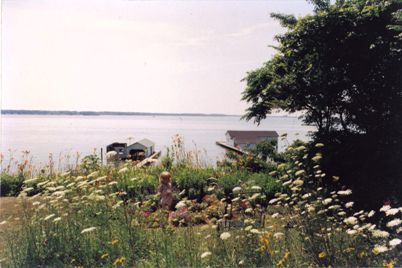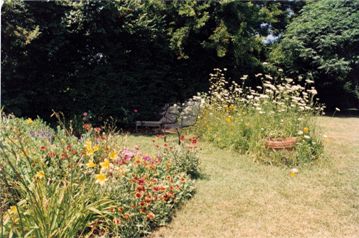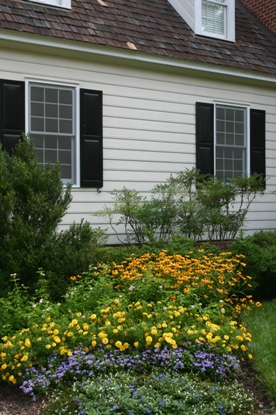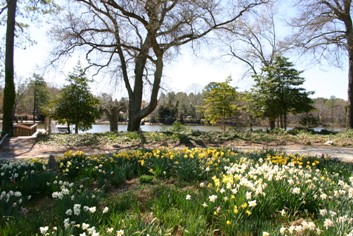Perennial Landscape Design Takes Planning !
Maximize your success when designing with perennials! This perennial landscape design looks free & easy like it happened without any thought! This could not be farther from the truth. Read on to learn about arranging and organizing these wonderful flowering plants!

Perennials are herbaceous, flowering plants that do not die over the winter. The top growth dies back each year, but the roots stay alive. Therefore, they come back the following year and get thicker and stronger. There are some evergreen varieties that keep their foliage up all year.
A small number of perennials bloom for
more than a few weeks, but most of them bloom
for just a few weeks out of the season.
Keep this in mind when choosing plants for your
perennial landscape design. You want it to look
colorful all season.
Use sweeps of plants (masses of one plant
laid out in an organic or sweeping shape) that blend
and flow with other sweeps of plants.
Don’t plant the flowering plants in a mixed up
or scattered pattern. Design the bed with the
blooming time in mind. Using masses of plants
gives an impressive display of color when the
plant is in bloom. It is amazing how one full
mass of blooming plants can carry the look of the garden.

In this perennial landscape design the tall, white
flower is Queen Ann's Lace. It is a native wild
flower that loves hot, dry conditions like you
would find here. Gracefully interspersed with the
Queen Ann's Lace is the yellow, native Coreopsis.
These delicate flowers are a similar height and
bloom at the same time. Notice how the
plants are arranged in sweeps making them look
natural and full. A gorgeous show of
flowers is enjoyed for three to four weeks!
The flowers in the rest of this perennial
landscape design also have a planting order that
looks natural and unplanned. The low
growing, yellow and orange flower in the foreground
is planted in a sweep with a mass of dwarf, yellow
daylilies behind it. The orange and yellow flower is
gaillardia, also known as blanket flower. It is a
plant that is amazingly adapted to hot temperatures
and sandy soil. I have seen it blooming in sand dunes.
It also blooms all season which is uncommon for a
perennial. The dwarf yellow daylily is a bit taller
than the gaillardia giving height variation. Tall
daylilies are behind the dwarf ones giving another
gradation of height and color.
Here is a list of some good performing perennials for the mid-Atlantic region and their sunlight requirement:
- Yarrow (sun)
- Queen Ann’s Lace (sun)
- Columbine (part shade to sun)
- Aster (sun)
- Astilbe (part shade to shade)
- Bluebeard (sun to part shade)
- Bachelor Button (sun)
- Coreopsis (sun)
- Ice Plant (sun)
- Pinks (sun)
- Bleeding Heart (part shade to sun)
- Foxglove (part shade to sun)
- Purple Coneflower (sun to part shade)
- Blanket Flower (sun)
- Cranesbill (part sun to shade)
- Wandflower (sun)
- Daylily (sun to part shade)
- Candytuft (sun to part shade)
- Monarda (sun)
- Peony (sun to part shade)
- Summer Phlox (sun)
- Black-eyed Susan (sun to part shade)
- Salvia (sun to part shade)
- Lamb’s Ear (sun to part shade)
- Verbena (sun to part shade)
- Veronica (sun to part shade)
All these perennials have many different
varieties to choose from. You have different
heights and colors. Arrange the plants so that
the tallest plants are in the back. Graduate the
size of the plants to the front. Think about
blooming time, so it will be full of color most
of the season.

To keep your perennial landscape design full
of color the entire growing season you may add in
annuals and bulbs. Annuals do not overwinter,
but die after the first hard frost. It is a job in
the spring to replant them, but they do have an
important role. THEY PROVIDE COLOR ALL OF THE GROWING
SEASON! This is a tremendous help. Add sweeps of
annuals among the perennials and your garden will have
blasts of color all season. Some of my favorite
annuals are lantana, annual vinca, globe amaranth and
impatiens.
Black-eyed Susan, a perennial that blooms from
July-September, is in the back of this perennial
landscape design. In the foreground are two annuals,
marigold and ageratum, that keep the bed colorful
from May to frost. This planting is at the front
entrance of their house where it is highly visible
and desirable to have it looking its best!

The technique of interplanting a perennial
landscape design is a way of making it come alive
earlier in the spring. Spring flowering
bulbs, such as daffodils, tulips and hyacinths can
be planted in the same planting space as your perennials.
For example, an area of your perennial garden that
is planted in daylilies can be interplanted with
daffodil bulbs. The daffodils come up in the early
spring. The daylily foliage comes up in the late
spring covering the dying foliage of the daffodil
and soon produces a beautiful summer flower. Spring
flowering bulbs are easily interplanted with most
perennials. Notice the newly emerging foliage growing
among these daffodils. They are daylilies. There
are tufts of other perennial foliage coming up too.
Do some simple maintenance on your perennials
to keep them blooming longer, looking better and
possibly reblooming. Removing the dead
flower heads (dead heading) is the best thing you can
do for your flowers. It certainly makes the plant
look better. For continuous blooming plants, it will
help them produce new flower buds faster. It may also
help some plants that normally wouldn’t flower again give
you another round of blooms.
Once the foliage of a plant starts to die
and is certainly becoming an eyesore to the perennial
landscape design, don’t be afraid to cut it back.
The foliage of daylilies and other perennials that bloom
early in the season have a tendency to get exhausted by
mid season. Cut the foliage back to the ground to
encourage a new flush of growth. These plants, in most
cases won’t flower again, but will put out pretty new
leaves that are now an asset to the garden, not an eyesore.
Perennials are one of my favorite ways of
adding color to the landscape. As well as
using them in cutting gardens and
cottage gardens
they add a lot of interest in the foreground of
a sweep of evergreen shrubbery dotted with flowering
trees. The evergreens are beautiful all year and
when the flowers are in bloom they are an added
bonus to the landscape.
Read books by Pamela Harper for more information
about perennials. Designing with Perennials is one of my favorite references by this author.
is one of my favorite references by this author.
Questions? I've got answers!
Ask
me a question about any landscape design issue or concern.
I will give you a quick response and a page on this
site dedicated to the topic. You can share it with
your friends and the readers will appreciate it too.
I hope to be hearing from you!
Please
contact me
for further information or to talk to me
about my design services.
Nancy Dransfield
Landesign of Virginia, Inc.
P.O. Box 15582
Richmond, Virginia 23227
Office: 804-261-6773
Fax: 804-264-7253
E-mail:
n.dransfield@verizon.net

Go to Next Page
Return from Perennial Landscape Design to Cottage Gardens
Return from Perennial Landscape Design to Homepage
Related Page:
Back Yards










